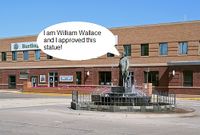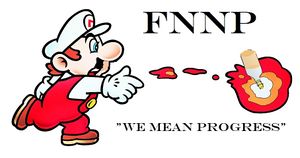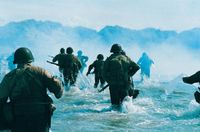Havre, Montana
Havre, Montana, often mistaken for being located in the state of Montucky, is a village founded in 1864 by Canadian explorer/rock vocalist Marco Polo. It is the oldest city in America and even surpasses Las Vegas, Nevada in age. The city of Havre is located on the Milk River which runs uphill, both ways, through the snow, and is said to have received its name from Native Americans who described the river as a great place to make White Russians. It is currently ruled by imperial governor Bobohead Johnson (incumbent). Here a statue of a James J. Hill is said to spit game at passers-by, often claiming to be William Wallace, a Scottish folk hero.
“ I thought I was in Siberia. ”
– Oscar Wilde on Havre
“ Havre has it, and if we don't, we'll order it from Great Falls and have it in next week. ”
– Anonymous Citizen of Havre on Havre
“ Want a bumper sticker?”
– Mayor Bob on Havre
History[edit | edit source]
Railroad Days[edit | edit source]
In 1864 when the railroad was being built through Montana, the need for an "end-of-the-line" disposable city had arisen. With the help of the Feather People, the city was built overnight. This night has well been documented as the first positive interaction between the European conquerors and the Native Americans and thus a screw-off day was named in honor of it. The initial influx of migrant railroad workers, mainly stemming from China and Japan, helped to build some of the world's finest underground opium dens, easily identified by purple colored skylights in the sidewalks of the city. The opium dens remained a great source of revenue for the city, until dry-land agriculture was introduced to the white man by the Native Americans in 1883. Agriculture took off quickly and after high yearly returns the government decided to start subsidizing an agricultural research facility/orphan forced labor camp. The facility is said to have successfully created and released the Polio virus, it is also said to have successfully created Twinkies, an innovative snack which has improved the quality of life for people worldwide.
A Call to Arms[edit | edit source]
During World War I, an American military recruiting station was set up on the edge of the border to entice Canadians to enlist under the US banner with the distant promise of eventually being granted American citizenship, as well as the promise of escaping the oppression of the Canadian government. Of course these Canadian recruits were sent to the front lines to act as human shields for the regular American units. At the end of the war, when the only three surviving Canadians returned; the battle-weary soldiers were immediately deported and given a severance voucher for three bottles of American Jack Daniels whiskey.
Some more stuff happened, and nobody really recorded it, then there was a guy named Simon Pepin, who reportedly was a major drunk-ass Frenchman who bribed the then mayor John Jenkens Jingleheimer Schmidt into naming a park after him in 1889. Then World War II approached. The Canadian jig was again attempted, but with less success than was experienced during World War I. Then there was the Korean War, the Vietnam War, the Global War of Terror (GWOT) amongst others. The city continued to produce cannon fodder for the wars as well as many alcoholics, spending millions on liquor annually, contributing to the partial recovery of the US economy during the late 2000s.
Birth of a 1ØØ Year Reich[edit | edit source]
On April 3, 1890, an armed conflict between the FNNP and the Republicans disturbed the peace and imperial governor John Jenkins Jingleheimer Schmidt authorized deadly force and imposed martial law to crush the uprisings. He ordered all buildings of commerce to be burned (See Scorched Earth Policy). The only building that survived was that of Buttrey's, a local grocer and general goods seller. Buttrey (the founder of the company) decided to jack prices up as high as possible to ensure maximum profits while holding an absolute monopoly on the market. In 2003 Buttrey's was bought out by Albertson's in retaliation (old grudges die hard). Eventually after the remaining belligerents of the so-called Hi-Line War were executed, the conflict ostensibly subsided, as there were no flare ups in the following decade.
On July 4, 1900 the FNNP elected Alois Hiedler, a German born right-wing conservative to the position of chairman of the party. This amounted to an outrage in the locality due to his hard-line stance on Windians. Subsequently, the Christian's Alliance for the Advancement of Jello (CAAJ) planted a bomb under the chairman's seat during a routine party meeting, luckily for Alois, he narrowly escaped the attack and swore that a path of retaliation would be sought. The five conspirators were later found by FNNP brown-coats, which dragged the suspects down main street to Town Square where a two-minute tribunal was held, they were then taken to the Havre Jello Factory, where they were drowned in the Jello vats as an example to any future would-be dissidents.
Winds of Chains[edit | edit source]
The imperial governor John Jenkins Jingleheimer Schmidt (J³.S), subsequently endorsed the FNNP and renounced its support of the CAAJ and requested protection from the brown-coats in exchange for a lifetime supply of free pudding. J³.S received criticism from the remaining members of the CAAJ who then went into hiding.
Run in With the Montana Militia[edit | edit source]
In 1903 Montana Militia Commander General Stephenson, known as a maverick to some, decided to attempt to invade the city of Havre to free it from what he saw as oppression of the citizens of Havre. This invasion plan was not approved by the imperial governor, however he decided, in his judgment that it was time to cut the red tape and act, which he called "shootin' from the hip." Gen. Stephenson assembled an invasion force of 20,000 ground troops, which he put through a rigorous training regiment prior to battle.
The Plan, Battle and Eventual Alliance[edit | edit source]
On June 6, 1904 Gen. Stephenson approved the plan to send 20,000 militia troops (most of which had to take time off from their day jobs) to invade Havre, Montana to free it from oppression. A force of 200 approached from the East to create a diversion, they were told they were the initial invasion force and that "reinforcements were coming" behind them, but Gen. Stephenson had more sinister plans. A force of 15,000 came in from the West, whilst the FNNP brown coats defended hardened positions along the Eastern flanks. The force initially met little resistance, and made it as far as 4th street when a surprise attack was unleashed. Unbeknownst to Gen. Stephenson, one of his militia troops worked at a local gas station, and was recruited as a spy for the FNNP. Their plan of attack was known one week prior. The 5th and 23rd regiments took heavy losses, and retreated to positions on the Western outskirts of the City.
On the night of June 15, 1904 The FNNP spokesperson Leroy Jenkins approached under a flag of diplomacy. Gen. Stephenson accepted their offer for the Montana Militia to surrender, on the basis that his remaining troops would be integrated into the FNNP brown-coats reeducation program as long as he swore loyalty to the FNNP. Gen. Stephenson appeased the offer and troops withdrew to their barracks, (for most jobs like McDonalds fry bitch, and Walmart stock bitch).
One of Gen. Stephenson's troops, a young Ted Kaczynski, disillusioned with the compromise made between the General and the FNNP, referred to as the Treaty of Thatguy, decided to go into hiding in a wooden cabin, where he wrote literature on an old fashioned type writer and lived happily ever after.
Demographics[edit | edit source]
At the 2032 census there were 13000 people living in the city of Havre. There were 379 households, all of which had one male son over the age of 40 living in their parents' basements. 95% were white guys and gals, with the other percentage being minorities, particularly Windians and the Native American tribe of the Mayans. 3% of people living in Havre had a middle school or above education, while 83% obtained a degree from "Harvard on the Hill," also known as MSU Northern
Education[edit | edit source]
MSU Northern[edit | edit source]
MSU Northern, founded in 1848 B.C. by George Orwell (the auto mechanic famous for "Carzilla"), is host to the world's most boring campus, dilapidated dorms, and boasts of the highest STD transmission rate per capita in the entire United States. According to a 2002 education effectiveness survey, MSU Northern placed highest in the most mediocre category across the board. MSU Northern is now expanding with a new windowless basement.
MSU Northern has been praised occasionally however for its endorsement of the arts, particularly that of KNMC 90.1 FM, a college radio station which played music people actually enjoy listening to. Unfortunately, in 1893 the rights to run the station were under coercion handed over to the FNNP propaganda department. Currently, only nationalist music is played, with the occasional exception of the Elvis song "Aint Nothin' but a Hound Dog."
School of Underwater Basket Weaving[edit | edit source]
Founded in 1849 during a basket weaving boom by Jesus Cristos, the school offers a wide array of educational opportunities, such as the ability to read books upside down, while smoking cigarettes. It also boasts of the second highest STD transmission rate (students of the SUBW often visit the dorms of MSU Northern).
Tourism[edit | edit source]
Havre offers a rare chance to look at a hole in the ground where thousands of years of mass-murder of Bison is preserved. It is adjacent to the Holiday Village Mall, which offers a rare opportunity to see what communism would look like if implemented in the United States. Naturally the opium dens are also a hot spot for would-be opium addicts, unfortunately opium is no longer provided in the Havre Beneath the Streets attraction. The Bypass is also keenly sought out by passing traffic. The local airline drops to below 20,000 on request but prefers not to land.There have been several overnighting tourists in the last decade and numbers 'are steadily rising' according to the Public lavatory attendant (Who has the unique Brochures made of soft white paper that is easy to flush) (Although recycling is strongly encouraged and its a very unique souvenir for those who have savoured the local hot spots- don't forget the Alsatian vindalloo-'guaranteed to keep you barking' long after you have gone beyond the town boundary.
Decline[edit | edit source]
Though briefly the location for the nation's capital and also used temporarily as an Amsterdam-like meth binging location for migrant hobos, it has seen a slight decline in quality of life. This is likely due to the influx of the Friendly Neighborhood Nazis Party (FNNP), a benign national-socialist party which has rigged elections in a bid to help the freemen to separate from the US government. Furthermore, their current party chairman Heinrich Loewenstein has stated, in his own words "...we wish only to reinstate a revised national socialist version of the Articles of Confederation, and to bring European style back into vogue!"


